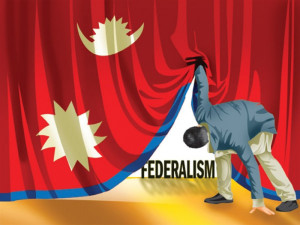Columns
Genesis of de-dollarisation
It would reduce our exposure to dollar-related swings and lead to a stable economic condition.
Krishna Sunuwar
Recently, de-dollarisation has been making headlines worldwide. The reliance on the US dollar for international trade and reserves no longer exists. For trade and reserves, governments worldwide use a variety of currencies such as the euro, yuan and bitcoin. This impending trend seriously threatens Western countries’ economic leverage and financial stability, particularly the US. Consequently, we should expect a paradigm shift in the global balance of power, drastically reducing Western influence over global financial systems while assisting the Asian economic boom.
According to World Dominion University, de-dollarisation can substantially impact a country's currency rate. When one reduces its dollar holdings and diversifies into other currencies, the demand for the US dollar falls, resulting in a depreciation against other currencies. This devaluation may increase exports by making domestically produced goods and services more competitive in international markets. Furthermore, de-dollarisation can reduce the risk of dollar-denominated debt, providing better control over debt management and possibly reducing borrowing costs.
Triggers for de-dollarisation
The triggering factors for de-dollarisation are different but massively interrelated to each other in the current upheaval. Above all, the long-term suicidal decisions of the US government to sanction countries like Iran, Russia and Venezuela have forced these nations to seek alternatives to the dollar. In addition, currency wars, where countries compete to devalue their currencies to increase exports, have made many nations wary of dollar dependence. The BRICS nations (Brazil, Russia, India, China and South Africa) actively promote trade in their currencies, significantly reducing reliance on the dollar. At the same time, persistent US trade deficits have another blow to the dollar’s long-term stability.
The rise of BRICS nations into the alternative of G7 countries is another strategic reason for the dollar's decline. These countries desire to transition away from a US-dominated global financial system by trading in their currencies, pushing them towards economic emancipation. This bloc has already taken the first step toward adopting a new currency to some extent.
The beginning of the dollar collapse can be traced back to 2014 when the US placed economic sanctions on Russia and prohibited dollar commerce internationally. This is the point at which many countries having issues with the US consider alternatives to the dollar. Numerous countries have negotiated bilateral agreements during the past decade to avoid the Russian experience, resulting in a 20 percent decline in the dollar’s value in global trade. According to the IMF, the dollar's proportion of the central bank's foreign exchange reserves dropped to 59 percent in 2022 from about 70 percent in 1999.
Geopolitical shifts
The definition of de-dollarisation and BRICS illustrates the narrow idea of de-dollarisation, which extends beyond the BRICS and has far-reaching implications for the global economic system. The growing use of bilateral currencies in international trade and finance demonstrates the government's strong desire to preserve its financial interests, strengthen monetary sovereignty and reduce exposure to external shocks. The global south has won some ground in replacing currency exchange techniques. However, the balance of power in the international financial system will alter substantially, affecting investment flows, exchange rates and global economic stability.
Historically, trading currencies have played an important role in shaping the global economic environment and geopolitical dynamics. Because of its extensive colonial territory, the Spanish real has served as a medium of exchange for international trade since the 16th century. The Dutch guilder first appeared in the 17th century. The British pound was a dominant currency during the 18th and early 19th centuries because of the British Empire. The US dollar rose to prominence during World Wars I and II when other emperors were absent from politics and the economic sphere. Due to the country's economic and financial prowess, the US dollar has emerged as the principal trading currency in the 21st century. However, the ascent of the European euro to some extent and the extensive entry of the Chinese yuan into the global market have posed a severe challenge to the US dollar.
According to the last 500 years of political and economic evidence, there has been a repeated pattern in currency substitution, with each empire holding its currency for approximately 100 years through international trade. We are beginning another upheaval that will reshape the economic powerhouse. The new aspect of this transformation will be the resurrection of Asian economic history after 500 years.
China is extending its vast use of the yuan and establishing an alternative financial system by strategically collaborating with other SCO and BRICS members. These countries collaborate in the de-dollarisation or unification of the global south, particularly Asia, Africa and Latin America, to protect the countries against Western financial instability or build a defense mechanism against the weaponisation of the dollar-based financial system.
Technological advancements
Rapid technical advancements, particularly in blockchain and digital currencies, have created simple and novel means to achieve the de-dollarisation agenda. It will provide many methods outside the traditional financial system while being neutral and efficient. Furthermore, it creates an entirely non-dollar-based infrastructure, institutions and market mechanisms without intervention from the conventional financial system.
In this environment, decentralising cryptocurrencies such as Bitcoin will appeal to world countries looking for various asset-reservation solutions. According to a Harvard University study, countries with a moderate risk of sanctions have opted to launch gold and Bitcoin allocations by their central banks. Countries such as Bhutan and El Salvador have begun to include Bitcoin in their reserves.
Cryptocurrencies allow decentralisation and borderless transactions, calling existing banking systems into question and lowering huge transition costs in cross-border trade. In this case, Russia and China have been examining the potential of creating digital currencies to replace the US dollar-dominated financial system. It is true that technical innovation has accelerated the process of de-dollarisation and has become an essential tool for diversifying currency reserves.
In this global overhaul of de-dollarisation, countries like Nepal would largely benefit as our economy will be less reliant on the US dollar for international commerce and financial activities. This transition will lower our exposure to dollar-related swings and lead to more stable economic conditions. Since Nepal has the lion's share of commerce with neighbouring nations such as China and India, employing local currencies might reduce transition costs and foster strong regional economic links. Furthermore, diversifying in foreign reserves like the rupee and yuan could stabilise Nepal financially.




 7.12°C Kathmandu
7.12°C Kathmandu













%20(1).jpg&w=300&height=200)

